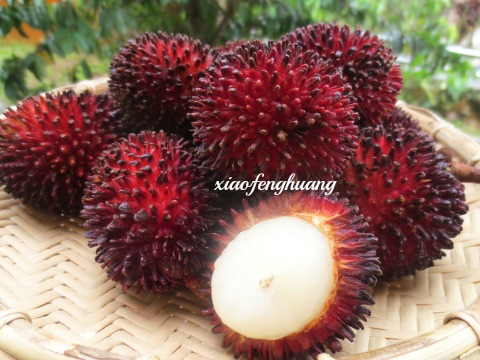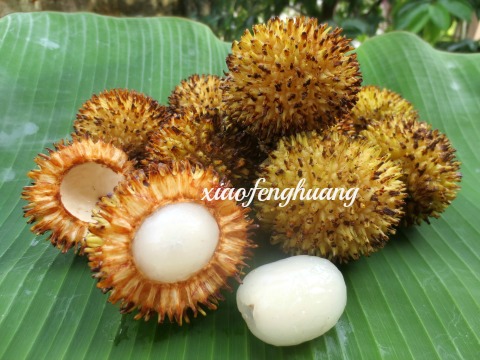Shown in the picture below is our hairless rambutan, mujau in Iban,buah redan(malay) a.k.a buak seriat in Melanau, is quite rare now but during fruit season can still be found at Serian market. Its botanical name is Nephelium maingayi Hiern.
These are tiny cute-cute hairless rambutan, about the size of a 10 cent coin, with skin looks like that of lychee and thin flesh tastes exactly like rambutan. Most natives call it rambutan hutan but Serian natives call it buah Keri. Iban name is buah mujau. While cultivated rambutans are always so sweet and juicy with bigger fruits and thicker flesh, who would bother to pay attention to these tiny hairless rambutans? Look at its attractive red skin. It looks good and tastes good too.

If you are lost in the rainforest, you will thank me for this post on our very own wild rambutan which is so sweet and juicy. It is best for quenching thirst in the jungle. Chinese name for this rambutan is San hong Mao Dang (山红毛丹). It is a seasonal wild fruit with trees giving fruits probably once in three years. It is as precious as gem stones and looks as pretty as one too. I think the pretty red skin can be used for red dye.

Pulasan (Nephelium mutabile Bl.) grows wild in the lowland forests in Sarawak but now is mostly semi-wild due to the high demand. The skin is thick with short and stumpy hairs. The thick rind can be easily squeezed open to reveal a translucent ,juicy, fragrant and sweet fleshy aril. The flesh does not stick to the seed like some varieties of rambutan.
Pulasan actually tastes more like lychee than rambutan. The fruit is slightly bigger than rambutan, oval-shaped and mature fruits can be yellow or maroon in colour. Pulasan seeds can be eaten raw. The seeds taste nutty, sweet and crunchy. Shown below is a picture of yellow skin pulasan which are mostly wild as compared to the red skin pulasan which are mostly cultivated.

And there are green pulasan which looks green even after it ripens. It tastes more like rambutan, sweet and juicy with its aril sticking to the seed. It is called pulasan because of its spiky look and its edible seeds which tastes exactly like pulasan seeds.
 Green skin pulasan
Green skin pulasan
Rambutan can be seen everywhere in the markets during fruit season but it is always less popular than durians and other wild fruits. Pulasan is always a better choice than rambutan. Other wild rambutans like the short hair mujan, sibau, gelurut and the dark red mertapang are not shown here.

The picture below show buah Mata kucing which is very unique because longan fruits are mostly cultivated in China, Thailand and other parts of Asia. There are locals who are not aware of the existence of our wild longans and to them, this wild longan is just another type of small longan imported from China or Thailand. One of the variety called ‘Isau’ should be ranked as top quality fruit found in Asia.

Its botanical name is Dimocarpus longan Lour.
Basically there are four varieties namely isau, sau, kakus and guring.
The ‘Guring’ is the only smooth and brown skinned longan. The other three longans have rough pebbly skin. All of them are about the same size, with 2 cm in diameter. All of them taste sweet and juicy with a distinct aroma.
The ‘Isau’ has green skin even when it is ripe and is known to be the best among the four varieties. It has thick and juicy flesh with small seed.
The ‘Kakus’ has brown skin and has biggest fruit among four of them but its flesh is thin and the seed is big.
The ‘Sau’ is a mixture of Isau and Kakus.
Kakus is more common than the other three. Wild longan is seasonal and not easily found in market.

There are a lot more to be found in our jungles. One native retiree told me he can easily survive without prepared food in his ancestor’s land for at least one month especially during durian and fruit season. As I am not a forest ranger, what I know is limited but then our rangers may not know as much as our natives who keep some of the knowledge to themselves. Sarawak rain forest is unique in the way that it has no tigers and elephants, may be that explains why we have so many ethnic groups, all together 27 of them and actually should be 42 unofficially.
Yes, that is life,
Life living like orang utan,
survive solely on the wild fruits alone.
Beware,
There is a super market hiding in the jungle.
Copyright claim – Do not crop any pictures from malaysiavegetarianfood.com.Do not share our pictures without any watermarked signature on them.Excerpts from our articles to be credited to malaysiavegetarianfood.com.

